NEXT GENERATION EU elections (and NRRP)
A pragmatic strategy for the common European debt.

Francesco Grillo's elaborated article in the column of Il Messaggero.
From the parliamentary elections of the next European Parliament, one undoubtedly expects a shift in the political balance towards positions that are outside the axis (popular-socialist) that has made the history of Europe for 70 years (even if already in 2019, the two big political groups lost their majority). It is, however, equally certain that, as the centre of the Union moves to the right, the same right is changing its position on Europe: today, no one questions any longer the observation that we need Europe to govern the greatest challenges (from immigration to defence). However, the very functioning of the Union will change, and among the aspects that must be at the centre of the election campaign is the financial one: should the Union provide itself with its resources without depending on a rigid budget that is set every seven years by the states? Was it a good idea to make common debt with Next Generation EU (NGEU), the large Union-funded operation to respond to the pandemic?
Undoubtedly, it is still too early to make a definitive assessment of the European Recovery and Resilience Plan (RRF). The same consideration applies to the Italian NRRP, which is worth 40% of that instrument. Some positive aspects are nevertheless emerging; together with shadows that are projected on the idea (of Draghi himself) of replicating the operation.
The novelty of linking payments from the Union to the states, no longer to expenditures to be reported (as with the structural funds), but to the achievement of certain results and to reforms that address structural bottlenecks, was excellent. Clearly, then, the plan is progressing faster than other cohesion policies. However, the impression is that the initial intuitions have not been followed, as is often the case in the Union, by sufficiently effective implementation.
First of all, it is hard to see the effects of an operation worth EUR 750 billion in gross domestic product figures. According to the ‘mid-term evaluation’ that the European Commission presented a few weeks ago, the European economy should grow 1.6 per cent more than in a scenario in which NGEU was not present. Instead, according to the Commission's own latest forecasts, the European economy will grow less in 2024 and 2025 (1.3%) than it did in the period before the creation of NGEU (2.2% in the five years before the pandemic).
The second doubt is on the issue of payments which may explain the still weak impact. There is not a sufficiently consolidated framework at the European level, and this is part of the problem. However, the feedback for Italy says that, according to the Ministry led by Raffaele Fitto himself (who is in charge of the NRRP), only 23.8% (45 billion) of the entire NRRP had landed in the current accounts of the beneficiaries (businesses and households) by the end of last year. The delay is very differentiated by ministry and, paradoxically, the one in the greatest difficulty is precisely that of health (we are at 4%) which was the one most affected by the pandemic to which the NGEU was designed to respond.
Finally, the famous ‘milestones’ and ‘targets’. There is an obvious difficulty not so much in achieving the former, which corresponds to the completion of procedures (and reforms) that enable RRF spending, but in meeting the deadlines of the ‘targets’ that measure the completion of investments. At the European level, of 324 targets planned between 2021 and 2022, only about one-fifth have been met, which may anticipate difficulty in completing plans by 31 August 2026 (the final date by which investments must be made available for use).
One cannot, of course, attribute responsibility for certain sufferings to those who - like, precisely, Fitto and Giorgia Meloni herself - have, from the outset, expressed doubts about certain characteristics of the NGEU. In fact, at least three hypotheses for improvement emerge.
First of all, more flexibility is needed and a timeframe at least coinciding with that of the EU budgets (seven years): recent history shows that, even just by moving from 2020 to 2022, we have passed from one era to another and there must be the possibility of reviewing the entire system. Secondly, the idea of rewarding the attainment of results should be confirmed: but wanting to monitor the progress of the programme through 6,234 indicators (527 for Italy) means breaking what was supposed to be a strategy into a huge bureaucratic fulfilment. Lastly, reforms are indispensable, the idea - in an era made uncertain by technology - that there is a manual of the perfect reformer to which the various countries must conform must be abandoned. It is the method of the ‘European semester’ that new political balances will have to rethink.
The European Union can never become the United States of Europe (as some election slogans evoke). Not only because it contains too much history and different languages, but because the era of the great states born between the eighteenth and twentieth centuries is perhaps over. And never in European history will there be an Alexander Hamilton, the first American economics minister who created an indissoluble bond between the former colonies by merging their public debt. And yet, when the NGEU was launched, there were many who likened the decision of Angela Merkel and Emanuel Macron to that of the founding fathers of the United States. Europe will continue to be a hybrid institution; one that will pool debt to respond to specific policies that have a continental dimension. It will have to do so, however, in a pragmatic manner. No longer be satisfied with the rhetoric of a political project that has had enormous merits. But it has the problem of having been conceived for a completely different century than the one we have to govern.
References:
European Commission (2024). "Spring 2024 Economic Forecast: A gradual expansion amid high geopolitical risks". Istitutional Paper 286. ISBN 978-92-68-13839-7. Link.
European Court of Auditors (2023). "NGEU debt management at the Commission". Special Report. ISBN 978-92-849-0394-8. Link.
European Parliament and of the Council Regulation (EU) 2021/241 of the of 12 February 2021 establishing the Recovery and Resilience Facility. (2021). Official Journal of the European Union document L 57/17. Link.
ItaliaDomani Piano Nazionale di Ripresa e Resilienza (2024). "Il quadro finanziario del PNRR". Link.

